1. Dear God did I want to like this.
2. I’m something of a fan of the Wachowskis. Bound and Speed Racer are fun, and I adore the Matrix Trilogy (yes, even the sequels). And I have nothing against Tom Tykwer, either. I enjoyed Run, Lola, Run, and admired his stab at making a Kieslowski (Heaven). I wish there were more filmmakers out there like the three of them.
3. Cloud Atlas is pretty well-directed. It presents six different plots across six different timelines, and (speaking for myself) it was easy to follow, narratively. That’s not nothing.
4. I’ve long argued that Titanic is a very well-made film. It’s three hours long, with dozens of characters, and it never becomes confusing, never drags.
5. This will not be the first time I compare Cloud Atlas with Titanic.
6. The best thing about David Mitchell’s novel was the way that earlier narratives kept turning out to be embedded in later ones. It’s a simple concept and it works. People have done their best to over-complicate the book’s structure, to make it seem like the trickiest thing ever …
… but, really, it’s just this:
Mind you, I have my problems with the book. The writing itself is overwrought, annoyingly affected, and quite frankly not worth the effort. It lacks the pleasures on offer in comparable works by Italo Calvino and Alain Robbe-Grillet. But I’ll readily admit that the structure is both clever and very elegant.
7. Cloud Atlas, the film, throws that elegance off a balcony.
8. Even more disappointing was the Wachowskis’ and Tykwer’s decision to flatten the sections stylistically. In the book, each time period is rendered in its own style. Thus, Adam Ewing’s Pacific Journal is presented as a journal, Frobisher’s letters to Sixsmith are presented as letters, the Luisa Rey mystery is presented as a pulp mystery, and so on. Despite my qualms with the actual (joyless) writing, I think delightful Mitchell’s omnibus approach.
However, in the film, each section is stylistically identical. I can understand why that was done. Once the Wachowskis and Tykwer decided to crosscut the six plots together, their mission became one of finding ways to make the different timelines flow into one another, emphasizing points of connection rather than rupture. But it’s a real loss.
Admittedly, the decor does differ some:
… along with the costumes, and (to some extent) the way that characters spoke. (Most remarkably, the filmmakers kept the screwy lingo of the “after the Fall” future post-apocalyptic section; that was bold of them. Me, I couldn’t understand half of Zachry and Meronym’s dialogue, but I was never at a loss as to what they were tellin’ with their say-sos, meanin’wise—an’ that’s the true-true.)
Ultimately, I found the film’s consistently bright and even style a letdown. Thinking back on it now, the only part that stands out stylistically is the scene where Luisa Rey and Sixsmith got trapped in the elevator.
I wouldn’t have predicted this going in. There’s a fair amount of stylistic diversity in the Matrix films, where the inside-the-Matrix sections present a wide range of possibilities …
… and differ substantially from the real world Zion sections:
Cloud Atlas takes place entirely in Zion.
9. Why were all of these changes made? In Aleksandar Hemon’s New Yorker interview with the Wachowskis, the siblings claimed there was just no way they could keep the book’s original structure:
The main challenge was the novel’s convoluted structure: the chapters are ordered chronologically until the middle of the book, at which point the sequence reverses; the book thus begins and ends in the nineteenth century. This couldn’t work in a film. “It would be impossible to introduce a new story ninety minutes in,” Lana said.
Well, I’m not a filmmaker, but I don’t really see why not. Later in the article, the Wachowskis claim their ambition was to make a film comparable to 2001:
Andy agreed. “ ‘Cloud Atlas’ is our getting back to the spectacle of the sixties and seventies, the touchstone movies,” he said, rubbing his bald dome like a magic lantern.
The model for their vision, they explained, was Stanley Kubrick’s “2001: A Space Odyssey,” which the Wachowskis had first seen when Lana, then Larry, was ten and Andy seven.
Isn’t 2001 a movie that, um, keeps introducing new stories? (The third part with Dave and Frank and HAL, “Jupiter Mission,” begins about an hour into the film.)
10. “Rubbing his bald dome like a magic lantern”?
11. Anyway, even if the Wachowskis and Tykwer couldn’t keep the book’s original structure, it’s a shame they didn’t replace it with something more innovative or interesting than constant crosscutting. … Remember when this fun little moment happened?
That’s hardly the most innovative thing in the world—I think I’ve seen insurance commercials that use the same effect—but why is this the only time in the film when this happened? Why didn’t the movie explore more ways to tie its various strands together?
The 60s and the 70s will have to keep waiting to be reborn.
12. Arguably, the choice to scramble together all of the plots made the film both trickier to write/make and to follow. Comments that I overheard at the theater:
I am hopelessly lost.
What the fuck is happening?
That went right over me.
The degree of confusion surprised me; like I said, I thought the whole thing admirably clear. (I guess I’m just brilliant or something.)
But it’s apparent by now that the end result has not gone over like gangbusters. After one month, the film has grossed less than half its $100 million production budget. And as of Thanksgiving, it was entirely gone from theaters in Chicago (I caught one of the last screenings, one week ago). In the past two weeks, it’s dropped from over 2000 theaters to just 258, where it’s averaging $1601 apiece. Ouch.
13. Maybe they should have done some clever merchandising tie-in with soap?
14. Let’s get to the movie’s real problem. What’s really missing from the film version of Cloud Atlas is the book’s clever take on an old concern: “How are we written by what we read?” Like countless other novels—the tradition extends back at least as far as Don Quixote—Cloud Atlas the book understands itself as a book. Its stylistic shifts, coupled with its insistence that it is presenting actual found manuscripts (a journal, letters, a mystery novel, etc.) emphasize writing’s materiality—the way that writing is a technology. Crucially, later characters learn about previous characters and events only by reading about them—the previous time periods survive only as written records. (OK, plus one film.)
What survives warps the characters’ lives. Timothy Cavendish is partly motivated to write his screenplay after reading the mystery novel manuscript. Sonmi~451 learns to assert herself by viewing a fictional account of Cavendish’s own ghastly ordeal. Zachry later worships Sonmi, whom he encounters through her Declarations. (Mitchell bungled it some in these later chapters; he should have presented Cavendish’s experience as his screenplay, and should have had Zachry venerate the transcript of Sonmi’s interview with the Archivist. But whatever—the spirit persists.)
Not for nothing did Mitchell name Sonmi~451 partially after Ray Bradbury’s classic. While most people will focus on the dystopian similarities, I’d argue that the real reference is to Fahrenheit 451‘s ending, when Montag encounters Granger and the other exiles, all of them hard at work at memorizing books—at becoming books:
“[…] All of us have photographic memories, but spend a lifetime learning how to block off the things that are really in there. Simmons here has worked on it for twenty years and now we’ve got the method down to where we can recall anything that’s been read once. Would you like, some day, Montag, to read Plato’s Republic?”
“Of course!”
“I am Plato’s Republic. Like to read Marcus Aurelius? Mr. Simmons is Marcus.”
“How do you do?” said Mr. Simmons.
“Hello,” said Montag.
“I want you to meet Jonathan Swift, the author of that evil political book, Gulliver’s Travels! And this other fellow is Charles Darwin, and-this one is Schopenhauer, and this one is Einstein, and this one here at my elbow is Mr. Albert Schweitzer, a very kind philosopher indeed. Here we all are, Montag. Aristophanes and Mahatma Gandhi and Gautama Buddha and Confucius and Thomas Love Peacock and Thomas Jefferson and Mr. Lincoln, if you please. We are also Matthew, Mark, Luke, and John.” (144–5)
Reading Cloud Atlas along those lines, Sonmi~451 is Bradbury’s book; Luisa Rey is Thornton Wilder’s. And you think the Wachowskis, of all people, would have gotten that.
But Cloud Atlas, the film, constantly labors to conceal its artifice and materiality. The events of each timeline are presented the way most films do, as witnessed events: we just happen to be watching, somehow, what’s going on in each time and place.
What’s more, the film is entirely hermetic, so concerned with its own stories that it never branches out toward other movies, to the larger body that is cinema. The 451 reference, and the Soylent Green allusion—those were already in the book. The Wachowskis and Tykwer, as far as I could see, brought nothing new to the table—unless the flying ships in Neo Seoul were nods toward the Nebuchadnezzar in The Matrix.
I guess this shot might have been a shout-out to the ending of Star Trek V:
Cloud Atlas the novel is engrossed with examining writing and its effects. Cloud Atlas the film, in order to be a true adaptation, should have concerned itself with cinema and its effects. Admittedly, that would have been tricky, given the 1849 section, but it could have been done. (One idea: make it part of a period film that the folks in the 1930s were watching.) … Along these lines, Cloud Atlas really missed the boat in not referencing François Truffaut’s adaptation of Fahrenheit 451—a movie where, you know, Julie Christie played two different characters. (And she was absolutely fantastic!)
15. All of this is to argue that the Wachowskis and Tykwer remained too slavishly faithful to the book in a literal sense—but thereby lost the project’s larger meaning. Indeed, their adaptation severely warps Cloud Atlas. The film’s paucity of self-conscious artifice shifts the project’s weight entirely onto its more metaphysical aspects. Thus, the whole thing becomes a heaping pile of mush about reincarnation, accompanied by a healthy side dish of treacle regarding how the chosen ones are reborn until the day when they can finally throw off totalitarianism’s yoke (which recalls that tossed-off idea in the Matrix films that the machines destroyed Zion numerous times before Neo showed up to save the day).
The reincarnation angle gains yet more emphasis from the decision to have the principle actors play recurring roles across the different timelines. Rather than expanding the project’s scope, this conceit makes the proceedings feel even more self-contained—not unlike in the Star Wars Prequels, where a vast epic in a galaxy far, far away turned out to be the tale of a few feuding families. I didn’t realize when reading Cloud Atlas that it was the story of Hugo Weaving’s reincarnation across time as a bad guy. (Is he supposed to be like Sauron, or Voldemort?)
16. Bracketing off for the moment my concerns with the reincarnation angle, I’d argue that the acting conceit worked best when a viewer could tell that a particular actor was playing different parts. This turned out fine, for example, with all of the roles that Tom Hanks played:
But what did the more subtle repetitions accomplish? If I need a chart, or the closing credits, to explain to me that Halle Berry was playing some anonymous back alley Borg Collective doctor—well, what of that?
How do turns like that—while certainly impressive technically—help advance the film’s cosmic dream of eternal return? The more a performance was buried under makeup, the more it struck me as gimmicky—some pale imitation of Kind Hearts and Coronets.
I suspect that what happened was the filmmakers got so invested in the concept that they lost sight of their larger project. It became something clever to do for its own sake, and not geared toward any larger end.
(Christ, I am so not even touching the film’s whole yellowface controversy.)
17. I do think Cloud Atlas is a hell of a lot better than Inception.
18. But over the Thanksgiving holiday, I saw Lincoln, and that film’s willingness to take seriously the complexities of human concepts like “rights” and “freedom”—i.e., the ways in which our selves are written, socially and legally, by others—makes the revolutionary claptrap in Cloud Atlas look like … well, claptrap.
The Wachowskis, despite their apparent fondness for philosophy, never actually do the deeper thinking that philosophy requires. Cloud Atlas talks a big game about rebellion and revolution, but its ideas prove ultimately as shallow, and as superficially Manichean, as George Lucas’s.
19. All of this being said, I really did enjoy watching the film. I was entertained by it, and I admired a lot of it technically.
… Actually, the movie solved the major problem I had with Mitchell’s novel. Because while the Wachowskis and Tykwer jettisoned what was most impressive about Cloud Atlas the book (its overall structure and changing styles), they made the individual plotlines much more engaging. As I stated earlier, I prefer thinking about Mitchell’s Cloud Atlas to actually reading it, mainly because I find the book, taken page by page, tedious and unfun.
But with this movie adaptation, while the whole thing may add up to less than the sum of its parts, I find the individual parts fairly engaging. That is to say, I’d rather watch the dramatization of Adam Ewing’s adventure in the South Pacific than read his journal. (Actually, I’d still rather skip that section entirely, it being the weakest material in both the film and the novel. Give me the Sonmi and Cavendish sections, aka the best parts!)
The Wachowskis’ drops don’t add up to much of an ocean. But they’re entertaining enough drops.
20. I also found the movie more emotionally engaging than the book (which I find pretty dry). The crosscutting ultimately proves thoroughly cathartic. In the theater where I saw it, a lot of people choked up at the end.
21. I will neither confirm nor deny whether I, too, got the sniffles.
But, hell, I cry at the end of Titanic.
22. Speaking of which, here are some other recent films that Cloud Atlas reminded me of: Titanic, Forest Gump, The Fountain, The Tree of Life, The Adventures of Baron Munchausen. All of which are ambitious and technically accomplished films wrapped around cloyingly trite ideas.
However. One of Cloud Atlas‘s saving graces is that it doesn’t come off as pretentious. It’s too well-intentioned and goodhearted for that. It’s a generous, loving film.
I’d label it primarily naive.
23. Despite its flaws, I do wish there were more movies out there like Cloud Atlas, and more filmmakers like the Wachowskis and Tom Tykwer.
24. However. Cloud Atlas: The Movie accomplishes less in its 180 minutes than the Star Trek: The Next Generation episode “The Inner Light” does in 45.
… Actually, I prefer any good episode of TNG or Deep Space Nine to Cloud Atlas: “Cause and Effect,” “Parallels,” “The Visitor,” any of DS9’s Mirror Universe episodes, …
25. Oh, right; I almost forgot. Regarding the transcendent and resplendent Cloud Atlas Quartet: I’m afraid I didn’t leave the theater humming it, nor has it haunted my dreams ever since. But the piece that played over the closing credits did remind me to some extent of Michael Nyman’s magnificent Musique à Grande Vitesse.
Now there’s a tune worth dying and endlessly being reborn for.
…
In case you’re interested, here are other movie reviews I’ve written:
- Drive
- Lifeforce
- Prometheus
- Scott Pilgrim vs. the World
- Shoplifting from American Apparel
- Somebody That I Used To Know (yes, the Gotye music video)
- The Assassination of Jesse James by the Coward Robert Ford
- The Hobbit
- There Will Be Blood
- Total Recall + Showgirls
- Two-Lane Blacktop
- Vagabond (Sans toit ni loi)
And here’s an inventory of all my articles on cinema, including “How Many Movies Are There?” and “How Many Movies Have You Seen?” … Thanks for reading!
Tags: 25 Points, alain robbe-grillet, Aleksandar Hemon, Cloud Atlas, david mitchell, Fahrenheit 451, Fight Club, Inception, italo calvino, Michael Nyman, Outgoing Signals, Ray Bradbury, Star Trek, The Bridge of San Luis Rey, The Matrix, Thornton Wilder, Titanic, Tom Tykwer


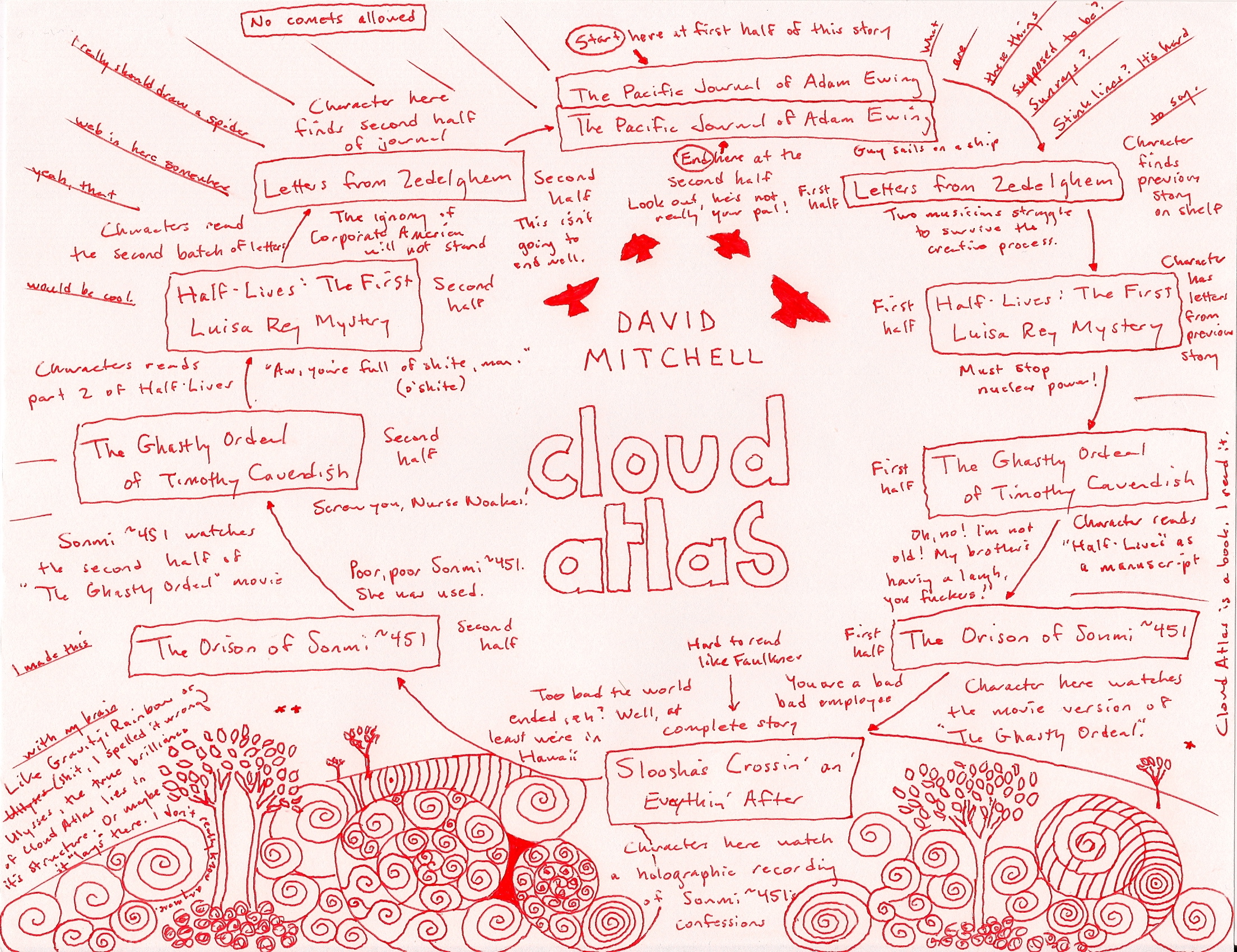

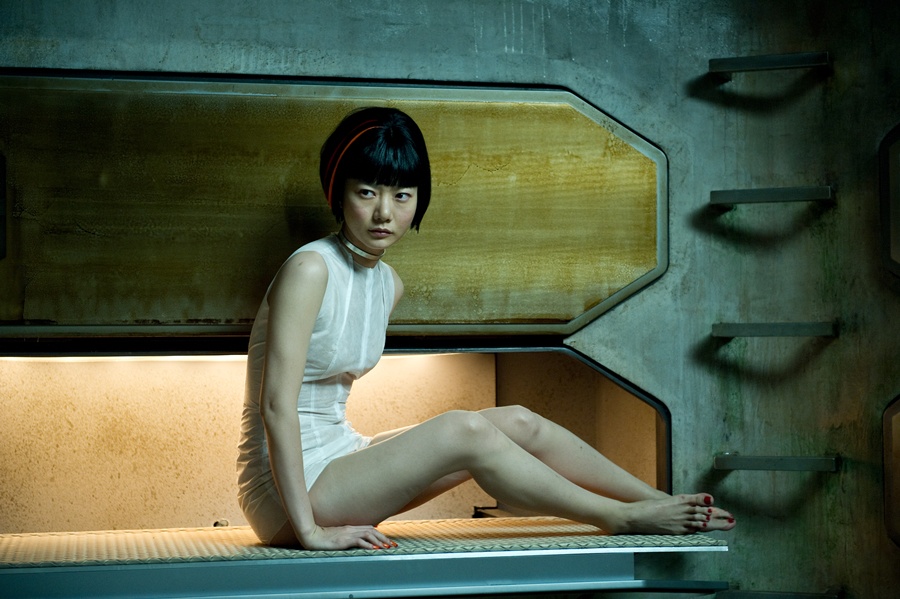
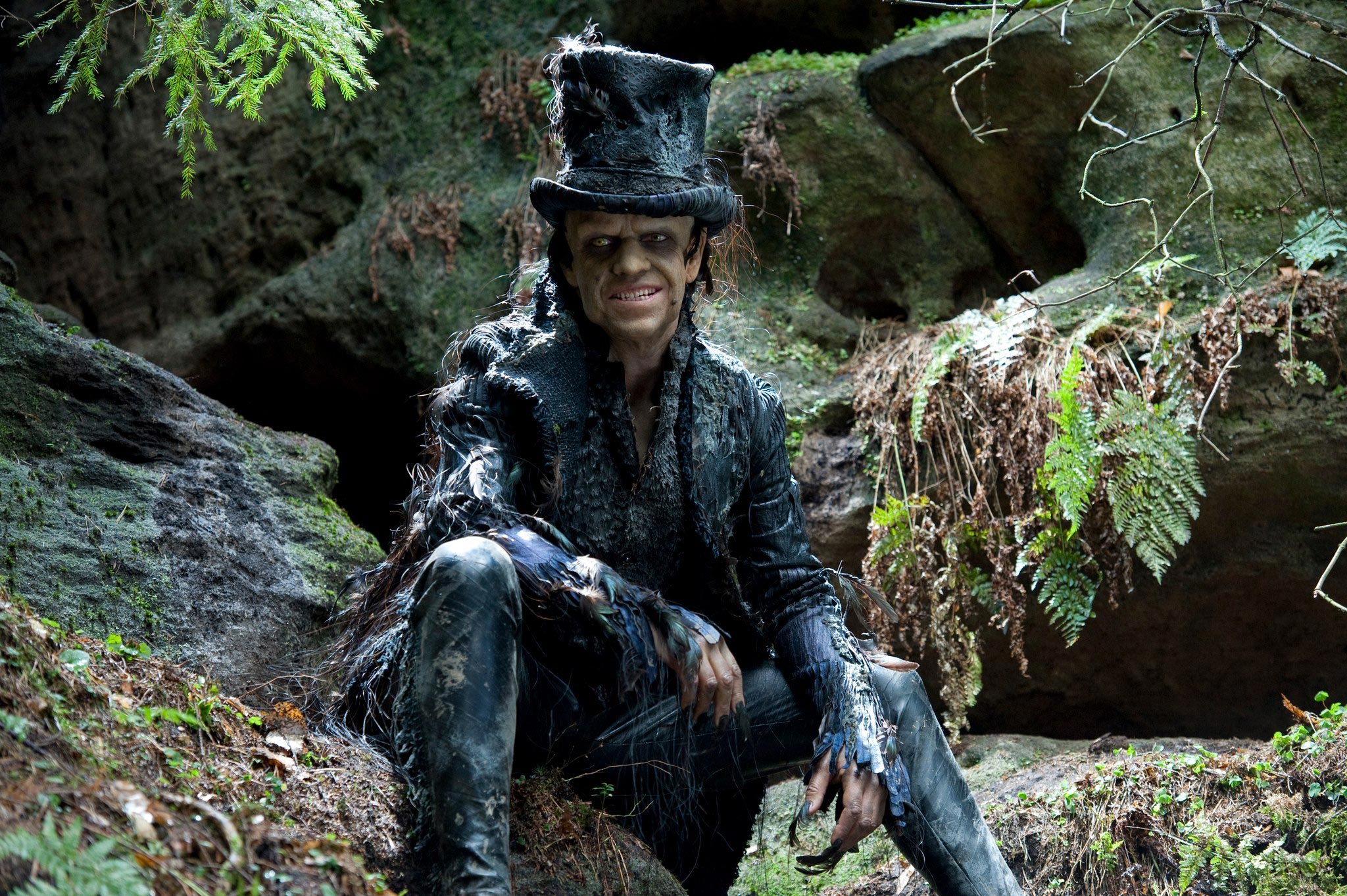
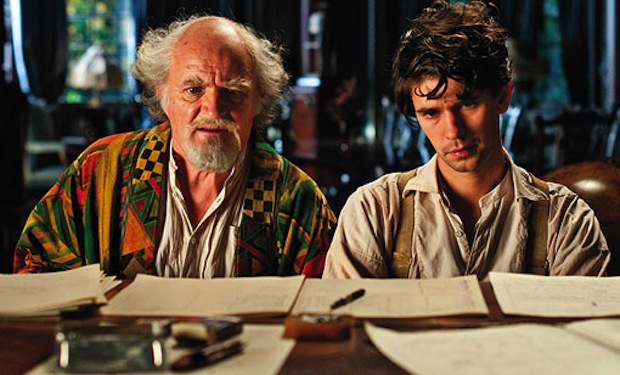
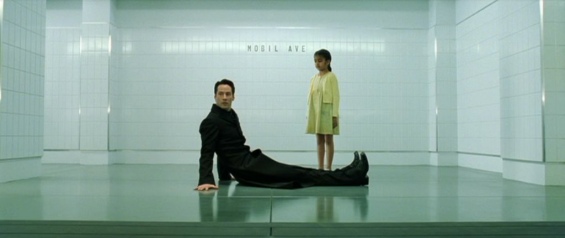
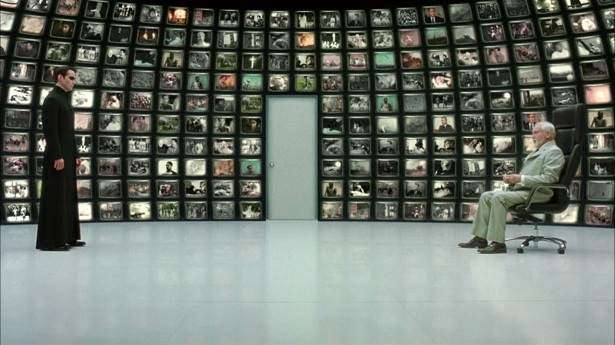
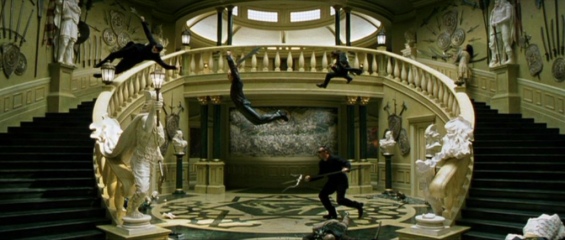
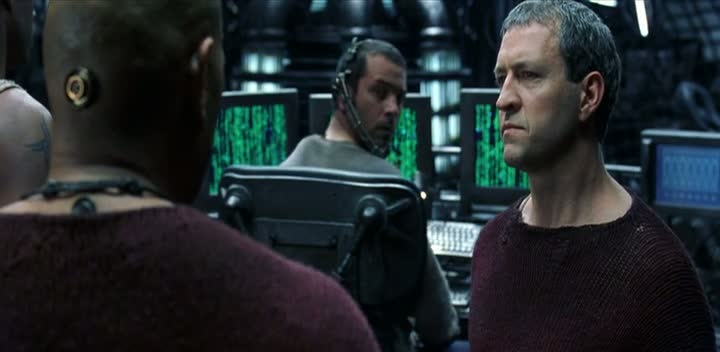
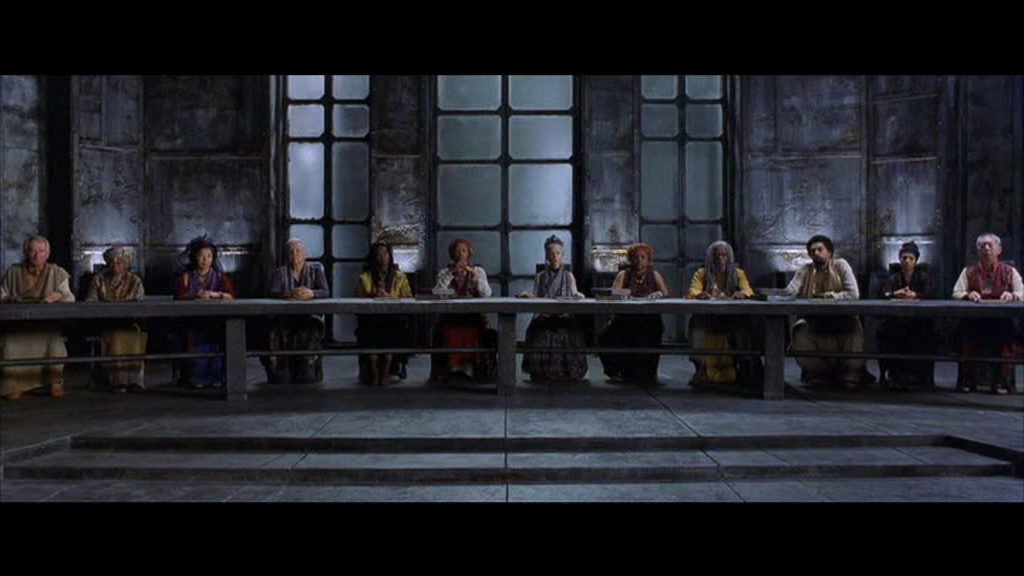
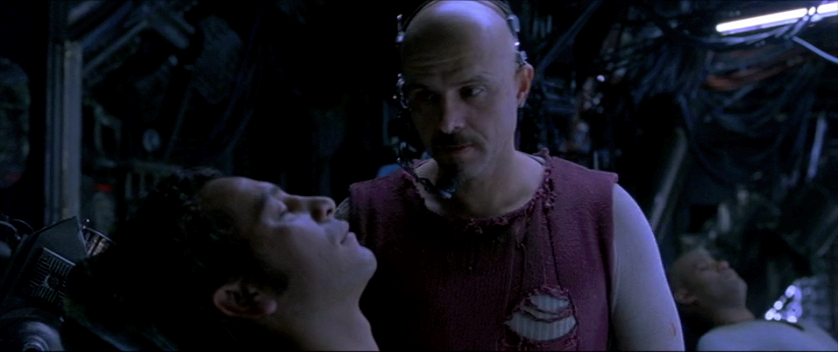
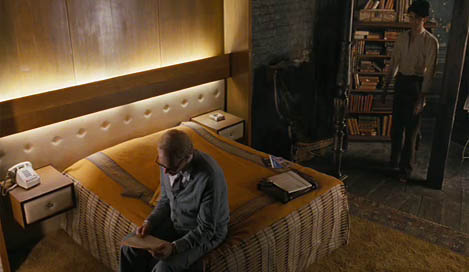

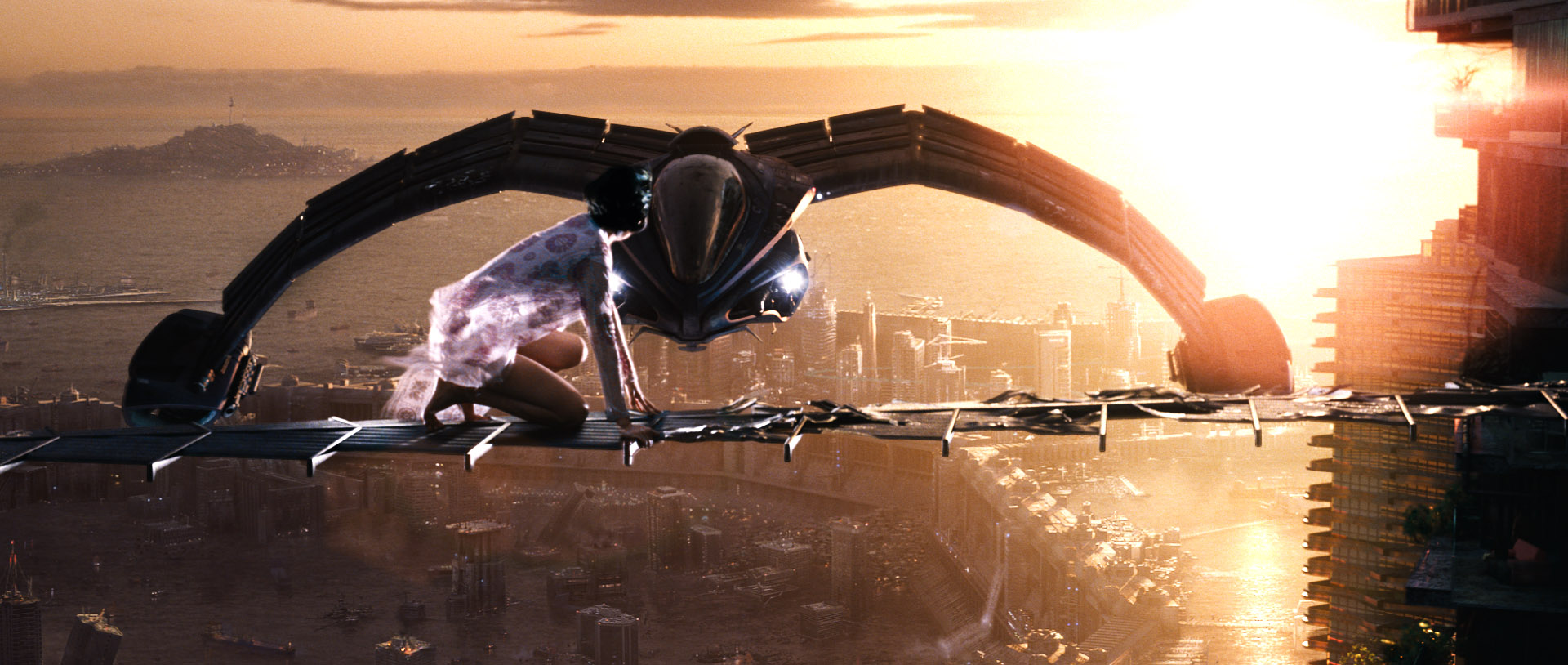


points 1-25: I want Ben Wishaw to fuck me
You mean…that is what you Whishaw?
I saw the new Bond movie last night and the central problem with it is that there’s this scene that hints Bond’s bisexual, and I couldn’t buy it, because if he were, he would’ve been all over Whishaw in the earlier scene at the museum.
who wouldn’t
there’s a reason he’s the new ‘Q’
Yes he’s Bond’s new Quartermaster.
Yes, in service to the Queen
The queen service, you mean.
You left out one infographic: http://www.scene-stealers.com/blogs/the-map-of-cloud-atlas-infographic/
4. To me, beyond the visibility of its budget, Titanic is well-done episodic (‘serial’) entertainment: its conflicts and arcs are bustled on and off stage economically. –but it never dragged for you?
6.
6. The writing in Cloud Atlas is–as diverse as the styles are–all precise, mellifluous, and emotionally effective. (It’s not all sad – when the action is funny, the writing makes you laugh – , but it’s all successfully tragic.)
9. The novel’s structure is not “convoluted”–a word used to mean ‘puzzling’, and often in the manner of a competitive obtuseness. I think you’re exactly right: this novel is structurally clever, not difficult, and, a story doesn’t have to be The Phantom of Liberty to defy Lana’s resistance to mid-narrative novelty. (–which convolution shuffling the six parts into a far more interleaved deck should order more accessibly?)
10. ‘magic lamp’: oil lamp whence, when rubbed, a genie. Why not–a mix of metaphor: a slide show (“magic lantern”) projecting the imagination of a djinn.
Or, an alliterative botch.
14. &15. The idea of transferring a diversity of written styles into analogous filmed styles is cool, but, to me, this aspect of the novel is in service of or in concert with a thematic unity not necessitated by stylistic diversity itself.
That story of each story which runs through all the stories is the accelerated late-modern factory-ization of our physical and social worlds. We manufacture environmental inhospitability to ourselves by treating the given world (including the society of other people) not as constitutive of each of us, but rather, as so many nails to the hammer of one-sidedly individuated acquisitiveness.
–at least, that’s what I thought the book is ‘about’, what it dramatizes. –and maybe there is a kind of necessity in reading the novel’s diversity as itself the facet-ing of its thematic unity: an ecological imperative.
20. (& 6.) I’d like to read more refutation–by, say, Mike Meginnis–of your calumniation of a great novel.
No, I knew you would chime in and link to it :)
Thanks!
Hey deegee,
4. No, Titanic never dragged for me, but to be honest I saw it exactly once in the theater, plus a couple of times on television (with commercials). I tend to like Cameron’s films, think them well-paced.
6. Yeah, I like the Sextet much better in the book…where I also can’t hear it. It’s worth adding that I found all the sixes stuff in the book more playful than anything. The whole film has a certain…somber slavish to it (haha) that reduces the novel’s playfulness to…prophecy?
The film misses a lot of the book’s humor, replacing it with a certain wide-eyed earnestness that I found simultaneously aggravating and endearing. Not unlike with a puppy.
I admire it in concept, but it just doesn’t work for me in practice. Like I said, I find it overwrought and joyless. But I won’t claim it doesn’t work for everyone (obv)—I know some people who love it. (Good on them!)
9. I really love the structure of Cloud Atlas the book. If nothing other than that, I think it’s a wonderful project.
I am a big fan of aesthetic unity, but I’m also very willing to grant credit where credit is due. If only one part of an artwork works for me, but it’s a brilliant part, I’m still very happy to praise it.
That said, part of what I love about the structure of Cloud Atlas the novel is its elegant simplicity. It may be difficult to summarize to people who haven’t read the book, but once you grasp it, it’s very simple. It’s wonderful!
10. I think you cracked it!
14. & 15. I really wish they’d found cinematic analogs for the different sections, and think it a real missed opportunity. (I did appreciate the brief clip we get of the film adaptation Ghastly Ordeal of Timothy Cavendish—and wish we’d seen more of it! That was the kind of thing I went in hoping for, and somewhat expecting from the Wachowskis, who were clever enough to include that clip from The Brides of Dracula in Matrix Reloaded.
… One thing I didn’t mention above, but thought about mentioning, is the project’s title. Mitchell is very careful to give his ideas about reincarnation literary form. When Zachry finally announces the book’s title at the end of his section, it’s relevant that he does so by means of a metaphor that alludes to a kind of book.
That’s exactly the kind of subtlety that’s missing from the film adaptation, which is really much more invested in some vaguely defined notion of lovers being reborn throughout time to eventually reunite and make beautiful babies on some far-off planet. (Gag.)
20. Not sure I followed this one, but I wasn’t trying to say that novels (or films) need or don’t need to be cathartic. I’m all for catharsis, but I also don’t think it is a necessary component of art, or novels. I was trying more to say that Cloud Atlas the film more cathartic than Cloud Atlas the book (surely this is related to the phenomena of Mitchell’s prose not really doing much for me, other than annoying me).
Is that catharsis a good thing? I dunno. The film did seem very invested in it, and I therefore consider it a successful aspect of the film. But I also think the catharsis in the film is pretty trite—akin to the catharsis in Titanic, or Forest Gump. So I don’t think the Wachowskis and Tykwer accomplished much there, honestly, besides making me (and other people) cry. (Which, at least in my case, is not a difficult thing to do.)
Always a pleasure hearing from you,
No. 6
6. The description of the composition of the Cloud Atlas sextet is a description, secreted in the novel Cloud Atlas, of the structure of that novel.
9. Yes, that’s right: explaining the structure of the nested stories, you worry that the other person will resist what you’re describing–pictured perfectly in the blogicle–as being needlessly complicated, but, once grasped (and probably quickly), that structure is cleverly simple (and, in my view, well-suited to the thematic consistency I see in the novel).
20. Was teasing (I like the writing a lot more than you do).
The book is surely not cathartic–the structurally central story – the last chronologically – is of the destruction of nearly everybody on Earth through war and environmentally triggered systems collapse.
You get to the end of the novel, and you realize (maybe much earlier) that you’ve watched, forwards from then backwards to a kernel, the germination and sprouting of humanity’s conscious, willful entwined genocidal and ecocidal destruction of the condition for the possibility of human life–the fulcrum of each of the stories, love.
I don’t see how ‘cleansing’ can have been Mitchell’s ambition, nor how it might be his accomplishment. –except in the way that an incisive dystopia can be thrillingly grim.
26. You know, reading the novel the one time I did, I never got the feeling that there was a transmigration of soul(s) from outwardly different character to character. I thought the birthmark was a kind of stamp on different souls condemned to their formal identity (ανθρωπος, human being), not that the same soul was living lives anew. Maybe a crucial interpretative plane that I completely missed?
(A novel that uses a group of people reliving lives through history (in the manner of bardo) is the alternative history Years of Rice and Salt, by Kim Stanley Robinson (of the colored-Mars series). I sure didn’t get the feeling in Cloud Atlas of reincarnation–not recurrence of individual souls, but persistence–and not–of species.)
6. Yes, and it’s possible that the music in the film does something similar, but it seems to me it’s another place where the filmmakers missed Mitchell’s formal playfulness/aesthetic unity.
9. I find the nesting part easy to explain to people, but the interrupting part—the hierarchical stacking—somewhat trickier. I usually explain it in two parts.
20. One thing I like about the structure is that the last story (chronologically speaking) is an oral tale, and contains the previous stories, which are all written accounts. It puts things backwards: what you think is a very written book is all nested inside a culture that has lost its history. But I think that you can read that as suggesting that, even given all the destruction, culture has been preserved—nothing has been truly lost, and humanity can begin again.
For me the crucial moment comes in Zachry’s story, when he mentions the “atlas of clouds.” He says that what the book demonstrates is that while there are many different clouds, and the clouds keep changing shape and forms, they are still always clouds; they just transform. The temptation then is to read the tales and characters in Cloud Atlas the same way. The Wachowskis and Tykwer certainly did.
… The book’s final line can also echoes that reading; Adam Ewing might as well say, “What is any cloud but a multitude of drops?” For me the reading is more along the lines of what I wrote in this comment, in #20, but when you read the Ewing line against the Zachry line, it does lend itself toward a reincarnation interpretation.
Now there’s a book title for you: The Reincarnation Interpretation.
… You know, I have read Ivy Compton-Burnett in the original Greek.
[…] Cloud Atlas (2012, Lana Wachowski, Andy Wachowski, & Tom Tykwer): I outlined my complaints in greater detail here, but simply put, I don’t think the Wachowskis and Tykwer really understood their source […]
Have you seen ‘A Cock And Bull Story’, AD? I’d say that wonderfully achieves what you yearn for in point 14- a book concerned with being a book adapted into a film concerned with being a film.
I think you missed the mark on a lot of these points. Namely, your overly harsh criticism of the style of the movie and the writing of the book. I also don’t think you fully grasp how difficult structuring any movie, let alone one with as many tricky elements as Cloud Atlas has, conceptually or that some things just won’t work on film as well as they do in a book. 2001 was not a case of them introducing new storylines in the middle of a movie and it working, that movie was about the evolution of man of course some new stories would start later in the movie…that’s cause it was a linear story. None of the characters were as closely related as they are in Cloud, that’s apples to oranges. And a reference to Fight Club when suggesting ways to boost their box office sales…really? You do know that movie failed miserably in theaters before becoming a success after dvd release, right? You put yourself on too high of a pedestal in this article to just be talking out of your ass through most of it,
I know Fight Club was a commercial flop; I was there. Indeed my point was that Cloud Atlas was flopping just like FC. But that doesn’t change the fact that advance critical audiences to FC were given soap as a promotion. Perhaps I was referencing something too “inside” film culture?
There are infinite ways to structure books and movies. In adapting Cloud Atlas, the Wachowskis and Tykwer eliminated precisely what I find so fascinating about the book, and I think that’s a real shame.
Thanks for chiming in,
Adam
I did see it! Back when it came out. My take on it was that it was less an adaptation of Tristram Shandy and more a vehicle for Steve Coogan and Rob Brydon, which I found (at the time) something of a letdown. But maybe I should revisit it? FWIW, I liked The Trip much better. Cheers, Adam
Thanks for the comment, but I’m not sure I’m following you. I don’t disagree that the book’s about how we’re shaped by the narratives we encounter. But even when viewed that way, Mitchell still bungled. Because the chapters preceding Cavendish’s are presented as written manuscripts that are physically encountered by the other (later) characters. So, in order to preserve the very pattern that Mitchell established, shouldn’t the Cavendish episode be presented in the form in which Soonmi encounters it? Of course she sees it as a film, and the novel can’t include a film, but the next best thing would be a screenplay. So I do think MItchell missed something there. Thanks again for chiming in & cheers, Adam
A really interesting article, thanks. I haven’t read the novel so cannot comment on how effectively the film has worked with – or chosen to deviate from – the book but thought I’d say something about my take on it thus far. Based on some of what you say above, I was clearly on the wrong track about several things – but I am as confused as I am intrigued. Firstly, the fact that most of the main actors played several roles made me think these were multiple incarnations of the same person who had diffent identities in different worlds across time and space (multiple universes, parallel universes, etc.). Secondly, this idea was reinforced by the incessant intercutting between these different narratives, suggesting that they may have been happening at the same time and events in these different worlds were influencing one another in some way as they were unfolding. This seemed quite an exciting prospect and I kept waiting to find out more about the connections between these worlds, thinking at some point it would be clear how a character could move between them. I am therefore hugely disappointed to hear that actually these events can easily be arranged in linear chronological order, all occurring on (or near) earth. It makes me wonder why all the intercutting was necessary and what the point was of having the same actor play multiple roles. At one point I thought the structure of the film as a whole was going to, in some inexplicably creative way, be shaped around the musical composition from which the film derives its name (and I was immediately disappointed that my lack of musical knowledge was going to make it unlikely that I’d really be able to identify or appreciate said structure. The only narrative in which I noticed any self-conscious references to the process of constructing a narrative was in the segment where Halle Berry plays a reporter. If, as you say, this kind of metafictional reflexivity was significant in the novel, then I’m sorry the directors didn’t make more of it. Yes, such techniques operate differently in film than they do in literature – but look at how brilliantly the film of The French Lieutenant’s Woman managed to highlight its status as a constructed narrative. At any rate, I am now really keen to read the novel and then return to the film once more – and possibly change my mind about it completely!
WOW! Not only the best thing I´ve ever read about the film and the book (I´m pretty amazed by both, while I can´t say how much I like them, exactly), but also about what I like to call “psuedo philosophical” pictures, such as you described George Lucas´, and Inception. And it´s a BIG relief to see that someone well instructed on the matter also thinks that. You made my day, thank you,
[…] Other movie reviews by me: The Dark Knight Rises | The Hobbit | Scott Pilgrim vs. the World | Drive | Lifeforce | Cloud Atlas […]
[…] Cloud Atlas […]
[…] HTMLGIANT, this review by contributor A D Jameson of the 2012 film adaptation of David Mitchell’s Cloud Atlas has […]